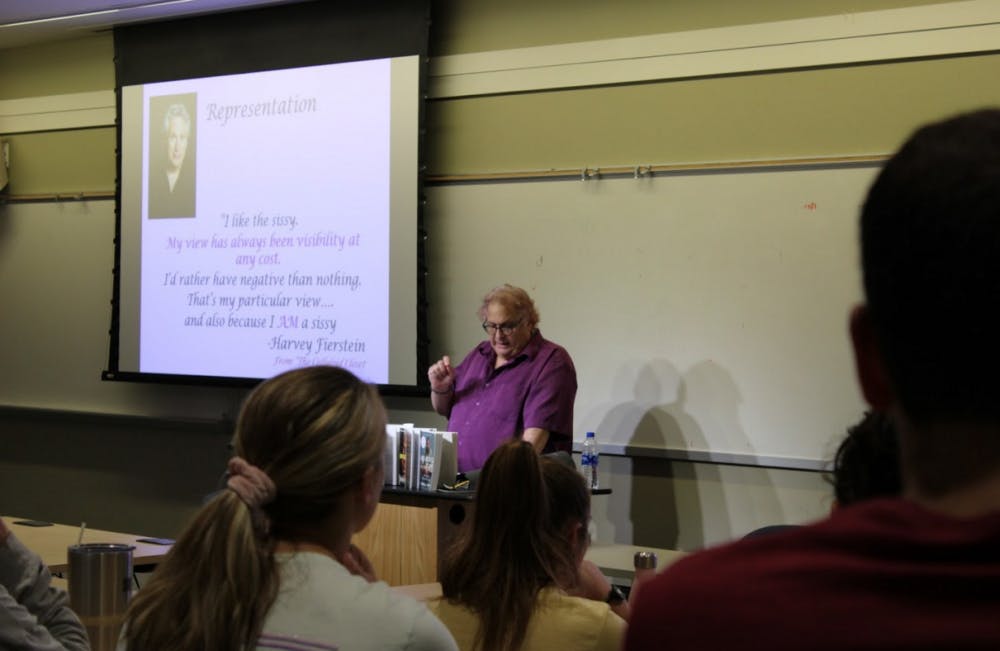By Garrett Cecere
Editor-in-Chief
In a sweltering high school classroom during the summer of 1987, Alan Amtzis approached his students with the hope of educating them. However, it was a quiet student who ended up teaching him a valuable lesson.

Amtzis, who stood up in front of his class of Latino, Caribbean and African-American students, was the only white person in the room.
“I was teaching a uniquely, uniformly white curriculum,” Amtzis said. “A novel, a play, a short story, a few poems and 150 vocabulary words.
On the class’ third day, one student — a 17-year-old Jamaican immigrant — who never spoke or raised his hand, walked up to Amztis’ desk and asked him a question that he would never forget.
“(He) gave what I call the ‘12-word challenge,’” Amztis said. “He said, very simply, ‘do you think we might read something more relevant to our lives?’”
Without waiting for a response, the student walked out of the room.
That day not only inspired Amtzis to search for stories that illustrated the experience of growing up black, Latino or Caribbean, but also set the foundation for his workshop that he led in the Education Building Room 113 as part of the College’s Community Learning Day on Sept. 4.
Amtzis changed the original name of the workshop, “Queer Images in Film,” so that he could focus on a more narrow scope and apply the session to themes in this year’s freshman summer reading book, “No Ashes in the Fire” by Darnell Moore, a memoir about the author’s experience growing up gay and black. The workshop’s amended title was “WE ARE: Images of Gay Black Men in the Movies.”
For the session, Amtzis showed clips from three films that depicted characters who are gay and black, in addition to others in the transgender community, all of whom are rarely seen on the big screen.
One film, “Tongues Untied,” is a non-narrative documentary where characters use poetry to express feelings and thoughts about their lives.
“What is striking about (‘Tongues Untied’) … is that there’s no apology,” Amtzis said. “It’s an affirmation, a statement of ‘WE ARE.’”
Amtzis, who now teaches in the College’s education department, enjoys exploring images of the LGBTQ community in cinema, which he is able to do with students in his FSP course, “Terms of En-QUEER-ment: A history of the movies and LGBTQ identity.”
Growing up in New York City, Amtzis was no stranger to theater and films, which served as support when he came out as gay at the age of 15.
“‘Women in Love,’ ‘The Boys in the Band,’ ‘Sunday Bloody Sunday,’” he said. “All of these movies celebrated who I was and what I was.”
Before going into teaching, Amtzis had worked in the film industry as a script reader and casting director early in his career, which contributed to his desire to integrate film into his lessons.
“...I love movies. I’ve been going to movies since I was 5 years old,” he said. “I’ve probably seen more movies than anyone you’ll ever know personally whose name isn’t Steven Spielberg or Martin Scorsese.”
Another film in the presentation, the Oscar-winning “Moonlight,” tells the story of Chiron, a young gay black man and his search for love and acceptance during three stages of his life.
Although they didn’t read Moore’s book, sophomores Stephanie Shen and Alex Reinhard, who attended the workshop, especially enjoyed the presentation about “Moonlight” and were impressed with how the workshop tied cinema with the LGBTQ community.
“I picked this (workshop) … because film is something I’m … interested in,” said Shen, a mathematics major. “The LGBTQ+ is also something that … I’m really passionate about.”
Reinhard, an English and interactive multimedia double major, admired how the presentation related to one of his classes.
“I’m taking queer lit this semester, so I feel like (the workshop) tied in everything really well, and this was a … good introduction to everything,” he said.
For the third film, Amtzis chose “Paris Is Burning,” a documentary about the ball scene in New York City during the late 1980s. He highlighted one character, a drag queen named Pepper LaBeija, by asking the audience participate and chant the name three times just like the actors did in one scene.
Amtzis said he enjoyed discussing “Paris Is Burning” the most and that he looks forward to showing it in his FSP course.
“(The film) is just so outrageous,” he said. “It’s these fierce, fabulous drag queens fighting for recognition … and yet, their social status is so marginal that there’s a real sort of tension in there that I find powerful … and having everyone chant Pepper LaBeija’s name.”
As Amtzis brought the presentation to a close, he answered one person’s question by saying how he felt “Paris Is Burning” helped shed light on an underrepresented group.
“(The film) gives a lot of focus and attention to a very marginalized group,” he said. “I guess they feel ignored, and their voice is powerful.”
Even three decades later, Amtzis hasn’t forgotten the challenge that his student presented him.
“To this day, I wish I could recall his last name,” he said. “I wish I could find him on Facebook because I owe him a ‘thank you.’”







